This focus idea is explored through:
Contrasting student and scientific views
Student everyday experiences
The modern world is rich with examples of complex machines whose workings are seldom understood. Students (and many adults) commonly use the word ‘machine’ to describe complex mechanical devices powered by an engine or electric motor and designed to perform useful labour saving tasks.
Students often believe that all machines produce much more work than their human operators put in. This view is consistent with their experiences of most powered mechanical devices e.g. chainsaws, electric power tools and hydraulic excavators.
Students’ everyday experiences seldom acknowledge devices like levers, inclined planes, wedges and pulleys as being types of ‘simple machines’. Although most students will have common experiences of the use of simple machines like levers and pulleys, few will have any understanding of why their design may provide an advantage or how they should be best employed. Many students also have difficulty in identifying or explaining these experiences to others and rarely identify parts of the human body, such as the arms or legs, as composed of levers.
Research: Hapkiewicz (1992), Bryan, Laroder, Tippins, Emaz & Fox (2008), Meyer (1995), Norbury (2006)
Scientific view
The word machine has origins in both the Greek and Roman languages. The Greek word ‘machos’ means ‘expedient’ or something that ‘makes work easy’. The Romans have a similar understanding of the word ‘machina’ which means ‘trick’ or ‘device’.
The basic purpose for which most simple machines are designed is to reduce the effort (force) required to perform a simple task. To achieve this, the force applied must act over a longer distance or period of time resulting in the same amount of work being performed by a smaller force. Screws, levers and inclined planes are designed to increase the distance over which the reduced force acts so that we can push or pull with less effort. The effect of this design is often referred to as providing a ‘mechanical advantage’.
The term ‘simple machine’ is commonly used by scientists to refer to one of six different types of devices which are often combined to form more complex machines.
| Scientific views of simple machines |
|---|
The lever (crowbar or claw hammer)Consists of a stiff beam that rotates around a fixed pivot point (fulcrum) located somewhere along the beam. Motion at one end of the beam results in motion at the other end in the opposite direction. The location of the fulcrum can magnify (or reduce) the force applied at one end at the expense (or advantage) of the distance over which the other end travels. |
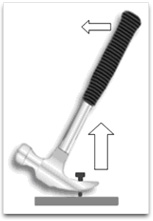
|
The wedge (log splitter or knife)Is used to convert a force applied in the direction of the wedge’s movement to a splitting action that acts at right angles to the blade. It is often used to split, cut or raise heavy objects depending on the angle of the sides of the wedge. |
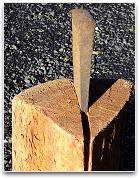
|
The wheel and axle (steering wheel or screwdriver)Combines a wheel with a central fixed axle which ensures that both must rotate together. A small force applied at the edge of the wheel is converted by rotation to a more powerful force at the smaller axle. This effect can be reversed by applying a large force to the smaller axle resulting in a smaller force at the edge of the larger wheel with much greater rotational speed. |
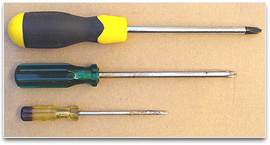
|
The screw (scissors style car jack or window winder)The rotation of a threaded shaft can be converted into movement in either direction along the axis of rotation depending on the direction of its spiral thread. A screw acts like an ‘incline plane’ that has been wound around a shaft. They are commonly used with gears or as a fastening mechanism. |
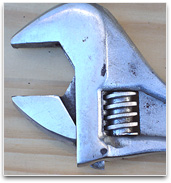
|
Incline plane (ramp or staircase)Is commonly used to raise or lower heavy objects. The large movement of the object along the ramp is converted by the angle of the ramp’s elevation into a smaller vertical movement. Given the friction on the ramp is small, a reduced force is needed to raise a heavy object vertically although it must be moved a greater distance along the ramp to achieve this advantage. |
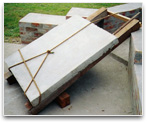
|
Pulley (block or curtain cord)The use of a single fixed pulley and attached cord allows for a change in the direction of the force applied to an object. Although a single overhead pulley provides no mechanical advantage it may be helpful, for example, in allowing a lifting force to be better achieved by redirecting the force down towards the ground to raise an object. Pulleys can be used in complex combinations to provide large mechanical advantages such as with the design of a ‘block and tackle’. |

|
Critical teaching ideas
- We commonly use the word ‘machine’ to refer to a complex mechanical device powered by a motor which is very different to our scientific use of the term ‘simple machine’.
- Simple machines are useful because they reduce effort or extend the ability of people to perform tasks beyond their normal capabilities.
- Simple machines that are widely used include the wheel and axle, pulley, inclined plane, screw, wedge and lever.
- While simple machines may magnify or reduce the forces that can be applied to them, they do not change the total amount of work needed to perform the overall task.
When addressing these critical teaching ideas it is important to assist students to identify common examples of ‘simple machines’ in their world. Students don’t readily identify examples of simple machines that they commonly use because many are in such wide use that they are easily and frequently overlooked.
For example, in the case of a common door handle, the location of the handle with respect to the door hinges acts as a lever to aid in its easy opening and a large round handle (or extended lever) provides a mechanical advantage to assist with the handle’s rotation.
 Explore the relationships between ideas in the
Concept Development Maps – Laws of Motion and Energy Transformations
Explore the relationships between ideas in the
Concept Development Maps – Laws of Motion and Energy Transformations
Teaching activities
Students often unknowingly have many common experiences with ‘simple machines’. When teaching this topic look to assist students to identify everyday examples of their use of ‘simple machines’ and provide them with insights as to the advantages of why a particular ‘simple machine’ may have been used for this task and the advantages it may provide to the user. Initially try to avoid introducing examples of everyday items that use complex designs involving combinations of more than one type of ‘simple machine’ so students can clearly see the purpose of the design. Later students can analyse more complex examples with the purpose of identifying the combination of elements they use in their design.
Open discussion via a shared experience
Bring in some tools which are clearly designed with the purpose of increasing the force that can be applied to them (bottle opener, crowbar, pliers, car jack) and initiate a discussion about what each allows us to do more easily. Guide this discussion so students become aware of how each is able to magnify the force applied to it. Encourage students to contribute more examples from their own experiences (using a screwdriver to get the lid off a paint tin is a good example of an experience many students will have had). Use this to introduce the notion of how levers and other simple machines are used more generally in their lives.
Focus students’ attention on overlooked detail
By examining the design and use of a range of common levers, bring out the ideas that each uses a ‘fulcrum’ around which they pivot and that the section of the lever that we move (often with the action of a small force) moves a much greater distance than the section that is applying the greater force.
Other simple machines can be introduced one by one by bringing in several examples of each and looking for common features. Steering wheels, screwdriver handles and windlasses are all examples of a wheel and axle; axes, log splitters, tacks and nails are all examples of wedges. The internet has many sites that provide multiple examples of different simple machines. See the links provided at the end of this focus idea.
Help students work out some of the ‘scientific’ explanations for themselves
Have students experience trying to screw the same screw into the same piece of wood with screwdrivers with handles of different diameters. Many hardware stores sell inexpensive sets of screwdrivers that have a range of handle sizes. Modest sized jeweller’s screwdrivers provide a good example of the reduced advantage they provide because of their small handle diameters. Consider removing the plastic handle from a screwdriver and encourage students to experience the difficulty of trying to turn a screw with the shaft alone. This experience can be used to highlight the relationship between the diameter of the wheel ‘handle’ and the size of the force you can generate at the axle ‘shaft’.
Collect data for analysis
After a list of items using different types of ‘simple machines’ has been generated, have different groups of students collect examples of each in common contexts such as garden sheds, kitchens, workshops, hobbies and sports.
Have students examine the design of each of these to identify the type of ‘simple machine’ they are based around and how they provide a mechanical advantage. Sailing boats are full of ingenious examples of pulleys; rowing boat oars provide one of a few examples where the fulcrum is located such that it reduces the applied force and increase the distance over which it acts. Generally levers are designed to magnify the forces applied to them. One objective is to highlight just how widespread the uses of simple machines are in our everyday life.
Clarifying and consolidating ideas for communication to others
Encourage students to research examples of large ‘simple machines’ in use before the wide spread application of steam engines or the internal combustion engine.
In medieval times society was very dependent on what were often very large ‘simple machines’ scaled up in size to generate large forces. Water wheels and windmills, medieval weapons such as trebuchets (which threw large stones or dead cows over castle walls), moat crossing bridges, castle wall ram and towers are just some examples that were based on the design of ‘simple machines’.
Different groups of students could research, construct scale models, study their design and report their findings back to the class on these spectacular simple machines.
Further resources
The following resources contain sections that may be useful when designing learning experiences:
-
Inventor workshop – This Museum of Science Boston website, assists students to identify elements of more complex everyday machines. Using a variety of materials, students imagine and design inventions to solve specific challenges.
-
Simple Machines - This Franklin Institute site provides activities based on identifying simple machines.